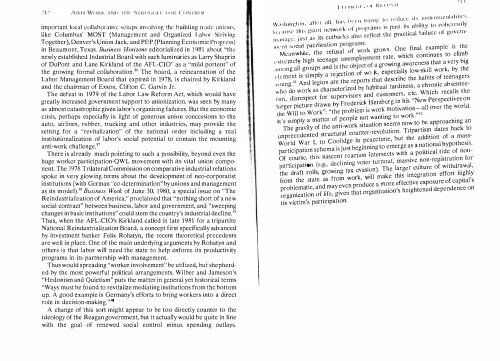CONTENTS - ouroboros ponderosa
CONTENTS - ouroboros ponderosa
CONTENTS - ouroboros ponderosa
Create successful ePaper yourself
Turn your PDF publications into a flip-book with our unique Google optimized e-Paper software.
important local collahorativL: setups involving the building trade unions,<br />
like Columbus' MOST (Management and Organized Labor Si riving<br />
Together), Denver's Union Jack, and PEP (Planning Economic Progress)<br />
in Beaumont, Texas. Rusiness Horizons editorialized in 1981 about "the<br />
newly established lndustrial Board with such luminaries as Larry Shaprin<br />
of DuPont and Lane Kirkland of the AFL-CIO" as a "mild portent" of<br />
the growing formal collaboration " The board, a reincarnation of the<br />
Labor Management Board that expired in 1978, is chaired by Kirkland<br />
and thc chairman of Exxon, Clifton C. Garvin Jr.<br />
The defeat in 1979 of the Labor Law Reform Act, which would have<br />
greatly increased government support to unionization, was seen by many<br />
as almost catastrophic given labor's organizing failures. But the economic<br />
crisis, perhaps especially in light of generous union conccssions to the<br />
auto, airlines, rubber, trucking and othcr industries, may provide the<br />
setting for a "revitalization" of the national order including a real<br />
institutionalization of labor's social potential to contain thc mounting<br />
anti-work challenge."<br />
There is already much pointing to such a possibility, beyond even the<br />
huge worker participation-QWL movement with its vital union compo<br />
nent. The 1978 Trilateral Commission on comparative industrial relations<br />
spoke in very glowing terms aboul the development of neo-corporatist<br />
institutions (with German "co-determination" by unions and management<br />
as its model)." Business Week of June 30, 1980, a special issue on "The<br />
Reindustrialization of America," proclaimed that "nothing short of a new<br />
social contract" between business, labor and government, and "swecping<br />
changes in basic institutions" could stem the country's industrial decline."<br />
Thus, when the AFL-CIO's Kirkland called in late 1981 for a tripartite<br />
National Reindustrialization Board, a concept first specifically advanced<br />
by investment banker Felix Rohatyn, the recent theoretical prccedents<br />
are well in place. One of the main underlying arguments by Rohatyn and<br />
others is that labor will need the state to help enforce its productivity<br />
programs in its partnership with management.<br />
Thus would spreading "worker involvement" be utilized, but shepherd<br />
ed hy thc most powerful political arrangcments. Wilber and Jameson's<br />
"Hedonism and Quietism" puts the mattcr in general yet historical terms<br />
"Ways must be found to revitalize mediating institutions from the bottom<br />
up. A good example is Germany's efforts to bring workers into a direct<br />
role in decision-ma k ing.""<br />
A change of this sort might appear to be too directly counter to the<br />
ideology of the Reagan government, but it actually would be quite in line<br />
with the goal of renewed social control minus spending outlays.<br />
I I I l\ 11 I I I "<br />
I · I . Iter -lil h . . , HIli r '<br />
\V ;I"; 1I11'. OIl, .1 "<br />
,' I \<br />
I II I, I I I 1',,\ 1<br />
. . I .. IlyilJl' t() rnllH:r its illslnllllcilialitil"s<br />
.<br />
I' . t 1 'tWOI k. ul pro!;.'rams is p.tS "<br />
!W\";llISl' t liS glat I L<br />
1I1i1lla)..',l, .iust as Its cuthac.::ks also ft.:. cc C<br />
lm'nl social pacificati(n programs,<br />
Mcanwhilc, the relusal of \Ol k gr<br />
t th ' practical failure or govcrn<br />
e<br />
e :wig awareness that a very big<br />
. One final example is the<br />
"':e which continues to climb<br />
g<br />
f rk<br />
'<br />
espeeiallY low-skill work, by the<br />
th<br />
t deserihe the habits of teenagers<br />
. b t<br />
. db h b·tual tardiness a chromc a sen ee-<br />
d· ct for supervIsors an eus , .<br />
ism, lsrespe<br />
d 1 'tomers et Which recalls the<br />
. k H b· rg in his "New PerspectIves on<br />
larger picture drawn by Fred Cfl<br />
bl<br />
c . er e<br />
k motivation-all over the world.<br />
the Will to Work": "the pro em IS wo<br />
It's simply a matter <br />
f people not wantmg to wor .<br />
. .<br />
The gravity of the antl-wor<br />
.<br />
k ,,42<br />
k situation seems now to be approaching an<br />
unprecedented structural counter rer: lO :<br />
e t the addition of a mass<br />
World War 1, to Coohdge 10 . pc e<br />
I r Tripartism dales back to<br />
u t e:nerge as a national hypothesis.<br />
participation schema IS Just beg1Omn 0 t. with a political tide of nOI1-<br />
. . .<br />
Of course, t IS na<br />
h· scent rcachon mterscc s<br />
. .<br />
( 0 dechmng voter urnou , .<br />
parhclpatlOn e .., . , , .<br />
the draft rolls, growmg tax c;aSl(; .<br />
from the state as from wor ,<br />
d<br />
Wl<br />
.<br />
f<br />
I<br />
t t massive non-registration or<br />
) The larger c ulture of withdrawa ,<br />
ke this integration effort highly<br />
;nore effective exposure of capital's<br />
problematic, and may even pro uce . fon's heightened dependence on<br />
oroanization of life, given that orgamza 1<br />
o<br />
. . .<br />
its victim's partlClpahon.






